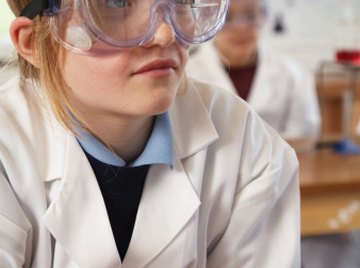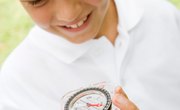
Assigning easy science projects is a way to introduce the scientific method to your kids or students. There are six main steps in a scientific method, most of which are included in every experiment your students will complete, regardless of the project's simplicity. The steps include asking a question, researching the issue, forming a hypothesis, testing the hypothesis with an experiment, analyzing data to arrive at a conclusion and stating results. Lead your students through potentially dangerous elements of an experiment, and ensure that both you and they wear the appropriate safety clothing at all times.
Plant Population Density
Challenge your students to write a prediction -- known as a hypothesis -- on what they think will happen during this plant-population-density experiment. Separate the class into two halves based on students’ hypotheses; instruct students to work as a group to develop a two-minute speech based on why they have made their prediction. Lead the classroom through the experiment as you set up two identical parts of an experiment design next to one another. Take two identical glass jars and fill them with the same amount of damp soil. Mark one glass "few" and plant two runner bean seedlings in it and mark the other glass "many" and plant 20 runner bean seedlings in it. Leave the jars on the same windowsill, so they receive the same environmental conditions, and water them every other day. Have students observe their growth and compare how the overcrowded and roomy growing conditions affect plant growth.
Acids vs. Bases
To conduct this experiment -- with the common scientific method of using controls and variables -- students should empty a medicine dropper of water, white vinegar (the acid) and ammonia (the base) into three separate, identical plastic cups. Students should then douse three single sheets of paper towel in one of the liquids before wrapping each around a mild steel nail. Have students leave their nails wrapped in paper towels on a side where they will be undisturbed overnight. Students should return and note their observations as well as take photographs that can be used in a presentation or at a science fair. Have students check on their nails once a day for a school week. Students should draw comparisons between the three different conditions and consider how the conditions affected the rate of the nail's rusting.
Magnets and Charge
This simple physics project gets students to think about magnetism and electric charge. Have your students take an iron nail that is roughly 6 inches long and approximately 20 inches of copper wire. Students should strip an inch of insulation from each end of the copper wire and wrap the middle section of the wire around the nail into a coil; ensure students leave at least 2 inches of copper wire at each end of the coil. Students should take both parts of the wire that are not coiled on the nail and attach them to the positive and negative terminals of a 9-volt battery. Get students to experiment with their electromagnet by passing it near iron filings or metal paper clips. Have students unravel half of the coils on the nail, pass the electromagnet near these items once more and see if they notice any difference in the magnet's strength.
Hawaiian Islands Geology
Easy science projects do not have to be based on students carrying out their own experiments; instead, they can focus on research from library books, journals and articles as well as Internet resources. One idea for a science project that centers on the background research phase of the scientific method gets your students to research the formation of the Hawaiian Islands. Students can look at historic ideas behind how the Hawaiian Islands were formed before thinking specifically about Hawaii's different volcanoes and mountain ranges. Educate your students about the appropriate ways of using resources and referencing the work they included during their research; this will prove valuable, particularly for students looking to continue into college. Suggest a specific style of referencing, such as the Harvard system, where your students must write the author name, then open brackets, and enclose the publication's year before closing brackets.
References
About the Author
I have been involved in coaching and administration of youth soccer with the Herts FA for several years. I have many years experience with the technical side and equipment of soccer, cricket, rugby, snooker and poker. I studied the health and fitness and dietary side of competitive sport while at University. Currently, I am not ready for on-camera opportunities, but this could change with access to training and equipment.
Photo Credits
Ableimages/Lifesize/Getty Images
